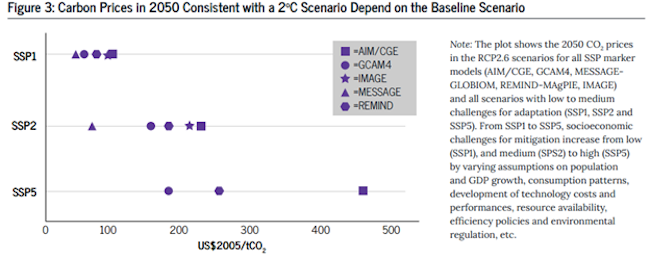
If adopted globally, the carbon price trajectory in the Energy Innovation and Carbon Dividend Act (H.R. 763) is likely high enough to achieve the science-based target of 2°C of warming or below.
Is this carbon price enough? Here’s what the experts say
By Jerry Hinkle, CCL Economics Policy Network
CCL volunteers are currently advocating for the passage of the Energy Innovation and Carbon Dividend Act (H.R. 763). The bill would put a price on carbon pollution, starting at $15 per ton and rising steadily $10 per ton each year. With 2020 promising record-breaking heat and hurricanes in the coming months, it’s natural to wonder: Is that price enough? Will that limit global warming to the science-based target of 2°C or below?
The U.S. generates only 15% of global emissions, so of course, we cannot “do it alone.” But U.S. actions can spur broader, global reductions. So as we explore the question of a sufficient carbon price, let’s ask: “If this carbon price were to be adopted globally, would the 2°C target be met?”
Fortunately, the world’s top climate economists have conducted extensive modeling on this general topic, and a reasonably clear consensus has emerged. We present two highly credible surveys here, and discuss what they imply about the adequacy of the Energy Innovation Act’s carbon price path.
UN report recommends a carbon price range
The UN’s High-Level Commission on Carbon Prices put out a report in 2017. The Commission was co-chaired by Nobel Laureate economist Joseph Stiglitz and former Chief Economist of the World Bank Sir Nicholas Stern, author of The Stern Review: the Economics of Climate Change.
Their report states, “The purpose of this Commission is to explore explicit carbon-pricing options and levels that would induce the change in behaviors […] needed to deliver on the temperature objective of the Paris Agreement, in a way that fosters economic growth and development.” They concluded that “the explicit carbon-price level consistent with achieving the Paris temperature target [of 2°C] is at least US$40–80/tCO2 by 2020 and US$50–100/tCO2 by 2030, provided a supportive policy environment is in place.”
The report made clear that the impact of carbon pricing on emissions across the globe could not be ascertained with precision, so instead of a single price at a point in time, they provided a price range (e.g., $50-$100 by 2030). Further, they did not provide a price range beyond 2030, stating that countries should evaluate the impact the prices were having up to that point, and allow those results to guide future price changes.
Survey says…
The report also provided a survey of five top, credible models that estimate the global carbon price in 2050 required to meet a 2°C target. The graphic below from the report shows the results of these models within various Shared Socioeconomic Pathways (SSP) scenarios from the IPCC, which reflect that future warming will be a function of fundamental trends in societal behavior (1). Each SSP assumes socioeconomic trends, independent of carbon pricing, that produce a “business as usual” emissions baseline. We focus on the SSP2 results, as this is considered the “middle of the road” or most likely scenario.
These estimates indicate that a steadily rising global carbon price that reaches about $200 in $2005 dollars (roughly $265 in inflation-adjusted $2020 dollars) by 2050 would likely achieve the 2°C target. The Energy Innovation Act promulgates a price that begins at $15 per ton of CO2-equivalent emissions in 2020 and rises by $10 per ton each succeeding year, so it would reach $315 per ton of CO2-equivalent by 2050. Given that, the bill should lead to meeting the 2°C target if those carbon prices were adopted globally.
A second, much broader survey was published as part of the IPCC’s 1.5°C Report (see chapter 2, Figure 2.26). The IPCC considered global carbon prices required to meet both 1.5°C and 2.0°C targets. Because they considered a far greater number of models in the survey (over 30), the range of estimated prices required to meet the targets is broader, but the model estimates are wholly consistent with those in the UN report. The graphic below, from CCL Community, summarizes the data in the IPCC survey:
It shows the prices over the 21st century required to meet both the 1.5°C (blue bars) and 2°C (grey bars) targets, and is compared to a “maximum” Energy Innovation Act price in which the annual carbon price increase is $15/t instead of $10/t (green line). Note that the darker sections denote the middle 50% of model results. This comparison indicates that the higher CCL price vector, if adopted globally, would very likely achieve the 2°C target (i.e., Energy Innovation Act prices are generally higher than those required in the models) and could achieve the 1.5°C target.
According to the world’s top climate economists and the modeling literature they rely on, the Energy Innovation Act’s base carbon price path, if adopted globally, would likely result in the world readily meeting the science-based target of 2°C. If the higher annual increases of $15/t were triggered and adopted globally, there is some chance the 1.5°C target would be met. In sum, the carbon price trajectory promulgated in the Energy Innovation Act reflects strong, science-based emission reduction targets with a high likelihood of keeping global temperatures well below 2°C.
Footnotes
- As described in the link, the SSP scenarios reflect different socioeconomic behaviors which drive emissions in a business as usual (BAU) scenario. For example, in SSP1, it is assumed civilization generally makes efforts to live sustainably, so that BAU (no policy) emissions are lower, and a lower carbon price is required to meet the 2°C target (see graph). In contrast, in SSP 5, civilization utilizes fossil fuels to the fullest extent possible, BAU emissions are high, and it takes a higher carbon price to meet the 2°C target.
Jerry Hinkle is an economist who holds master’s degrees in Economics and Climate Policy.
The Economics Policy Network is a team of CCL leaders and supporters with a diverse background in the field of economics. These network contributors write regular guest posts, offering thorough insight into topics that fall within their expertise. Their resources are available in the form of white papers on CCL Community.






